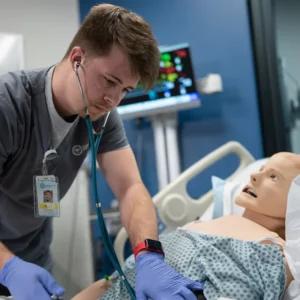Have you ever wondered what you could learn on the Carrington College Medical Assisting program [1]? This video highlights just a few of the things you’ll discover in lectures and labs, as told by some of our current students. By the way, if you’re considering a medical assisting career, the U.S. Bureau of Labor Statistics is projecting that employment of medical assistants will grow 23% from 2014 to 2024, which is much faster than the average[2] for all occupations. So what will you learn? “A lot! Anything from venipuncture, which is drawing blood, to urinalysis. Injections for vaccines – we’re learning that right now. Blood work, using the centrifuge to figure out people’s hematocrit levels. We do EKGs, audiology and Snellen [eye chart] which are the eye and hearing tests. Tons, tons more!” explained student Heather. “Lectures are really important because they touch everything we’re supposed to study and learn. Then the lab part is awesome, because you get to put all that into action,” explained student Michelle C. Student Jennifer M, explained that it’s not all back office work, medical assistants have front office tasks too. “Today we are learning about Optum and electronic medical records. We are learning how to input patients and make scheduling appointments, and review labs, all digitally.” “Today I learned how to use a microscope,” explained student Dominique B. “We actually viewed the skin cells, epithelial cells in the cheek – that was pretty cool!” she added. “The most important thing I learned was taking vitals; I think that’s pretty important because that’s basically what medical assistants do in the office,” said student Angelica M. So you’ll learn a ton of medical things on program, but what will you discover about yourself? “It’s helped me grow personally because I get to get to my next goal, so I’m real excited,” added Heather. “What I learned about myself is that I’m okay with getting out of my comfort zone,” said Jennifer G. “What I learned about myself is that I have to push myself a lot more; always know everything because everything they teach you here you’re going to use in the medical field,” explained student Tashara. By what about the “gross” stuff you may be wondering? “I haven’t really learned anything gross, but one thing I was really anxious about was doing injections in the glute [Gluteus maximus] – the backside, the behind, the butt cheek! I was really anxious about it but once I did it the first time…I kind of through myself in there, got it done, and it’s a breeze now!” explained Michelle C. Daasha H. believes that you’ve just got to get past that kind of stuff and move on – “As a medical assistant you’re going to see different things that are really weird, and you just learn to deal with it.” The weirdest thing I learned is that a sneeze can spread out to 200 feet which is kind of gross, and it goes to 100mph!” added Tashara, so always keep those tissues handy! Finally, if you’re considering going to medical assisting school at Carrington College, what advice do our students have for you? “If you want do it, just do it. There is no time like the present, and if you are even remotely interested you’re probably going to pretty much love it,” said Heather. “I should have actually started this program as soon as I graduated [high school],” said Dominique So what are you waiting for? If you’d like to learn more about the Medical Assisting Certificate or Associate Degree program[3] at Carrington College, click here.
[1] For comprehensive consumer information, visit https://carrington.edu/degrees/medical-assisting/ [2] Bureau of Labor Statistics, U.S. Department of Labor, Occupational Outlook Handbook, 2016-17 Edition, Medical Assistants, on the Internet at http://www.bls.gov/ooh/healthcare/medical-assistants.htm (visited July 08, 2016). [3] Program availability varies by location



